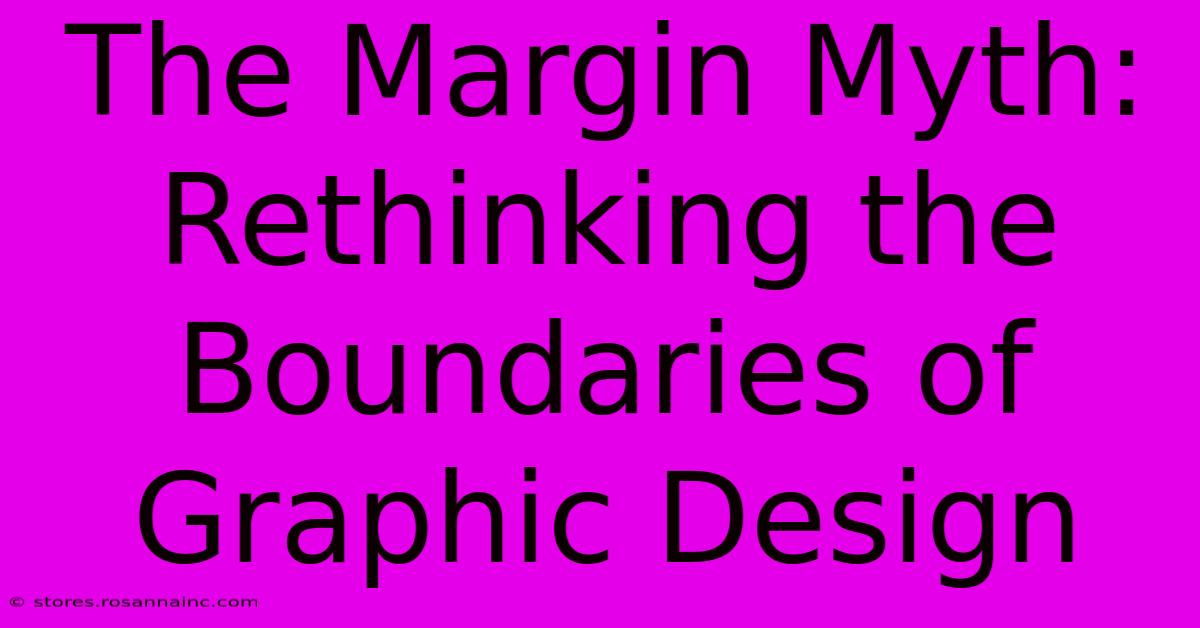The Margin Myth: Rethinking The Boundaries Of Graphic Design

Table of Contents
The Margin Myth: Rethinking the Boundaries of Graphic Design
The humble margin. Often overlooked, it's relegated to the background, a silent player in the symphony of visual communication. But what if I told you that this seemingly insignificant space holds the key to unlocking a whole new level of design impact? This article dives deep into the "margin myth," challenging our conventional understanding of margins in graphic design and exploring how their strategic manipulation can elevate your work to new heights.
Beyond the Blank Space: Understanding the Power of Margins
For years, graphic design has adhered to a set of established rules, dictating specific margin sizes and placements. These rules, while offering a solid foundation, often stifle creativity and prevent designers from pushing boundaries. The truth is, margins are far more than just blank spaces; they're powerful design elements capable of influencing:
- Readability and Hierarchy: Properly used margins guide the reader's eye, creating visual hierarchy and improving overall comprehension. Poorly used margins lead to cluttered, overwhelming designs.
- Visual Breathing Room: Margins provide essential "white space," allowing the design elements to breathe and preventing a cramped, claustrophobic feel. This white space is crucial for creating a visually appealing and user-friendly experience.
- Branding and Aesthetics: The choice of margin size and style directly impacts the overall aesthetic and brand identity. A minimalist design might benefit from generous margins, while a busy, energetic design might use tighter margins.
- Emphasis and Focal Points: By strategically manipulating margins, you can draw attention to specific elements, emphasizing key information or creating a strong focal point.
Debunking the "One Size Fits All" Approach
The myth lies in assuming a single, universally applicable margin size. The optimal margin size is entirely context-dependent, influenced by:
- Content Type: A poster design will likely have vastly different margin requirements compared to a website layout or a book cover.
- Target Audience: Consider the demographics and preferences of your audience. What feels comfortable and visually appealing to one audience might feel jarring to another.
- Medium and Format: Margins need to be adapted to the specific medium—whether it's print, web, or mobile.
Rethinking Margins: Creative Applications and Techniques
Let's explore some unconventional approaches to margin usage that can revitalize your designs:
Asymmetrical Margins:
Break free from the symmetry! Experiment with asymmetrical margins to create a dynamic and unexpected visual impact. This can add a sense of movement and energy to your design.
Negative Space as a Design Element:
Embrace the power of negative space. Strategically placed large margins can become design elements themselves, adding visual interest and enhancing the overall composition.
Interactive Margins:
In web design, margins can be used interactively, responding to user actions or screen size. This creates a more engaging and dynamic user experience.
Micro-Margins and Tight Layouts:
Don't shy away from using micro-margins to create a dense and impactful layout. This can work effectively for bold, modern designs.
Conclusion: The Margin Revolution
The "margin myth" highlights the importance of moving beyond conventional rules and embracing experimentation. By understanding the power and versatility of margins, designers can create work that is not only visually appealing but also highly effective in communicating its message. It's time to rethink the boundaries of graphic design and unleash the full potential of the humble margin. So, go ahead, break the rules, and design with intention. The results might surprise you.
Keywords: Graphic Design, Margins, White Space, Negative Space, Typography, Layout Design, Visual Communication, Branding, Web Design, Print Design, Asymmetrical Design, Design Principles, Creative Design, Design Techniques, Margin Design, Rethinking Design, Design Innovation.

Thank you for visiting our website wich cover about The Margin Myth: Rethinking The Boundaries Of Graphic Design. We hope the information provided has been useful to you. Feel free to contact us if you have any questions or need further assistance. See you next time and dont miss to bookmark.
Featured Posts
-
Greetings That Express Appreciation Discover The Most Effective Best Regards Synonyms
Feb 05, 2025
-
Timberwolves Vs Pistons Player Stats You Cant Believe Exist
Feb 05, 2025
-
How Perry Homes Sales Strategies Can Help You Secure Your Dream Oasis
Feb 05, 2025
-
Unleash Sheer Magic Discover The Dazzling World Of D And Ds Sheer Collection
Feb 05, 2025
-
Forge Legendary Encounters Expand Your Campaign With D And Ds Sheer Collection
Feb 05, 2025
